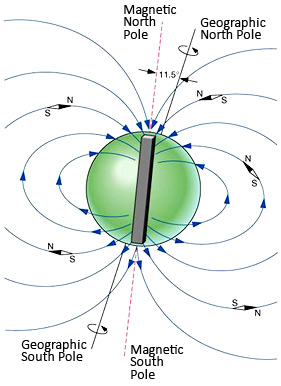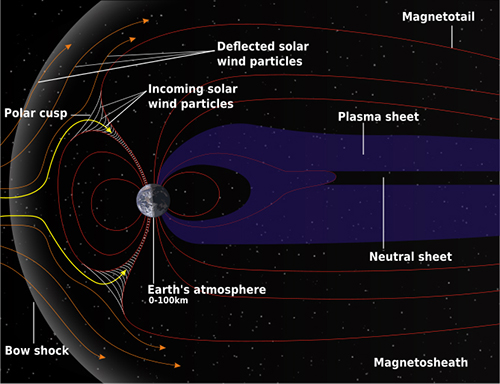In the figure above we see the onset of A3 and A4 oscillations.

The Schumann resonances occurring over an eight-hour period can be clearly seen at approximately 7.8, 14, 20, 26, 33, 39, and 45 hertz.
Earth has a strong internal magnetic field that appears to be generated by electrical currents in the liquid outer iron core that are driven by internal heat sources. The magnetic field resembles that of a bar magnet or “dipole field” with an axis tilted about 11.5 degrees from the spin axis, so, the magnetic poles are not the same as the geographic poles. Earth’s magnetic field strength was first measured by Carl Friedrich Gauss in 1835 and has been measured repeatedly since then. The field has shown a relative decay of about 10% over the last 150 years. The locations of the magnetic poles are not static; they wander as much as 55 kilometers every year.
The geomagnetic field is influenced by the sun and moon’s rotations, solar flares and probably interplanetary influences. Animals, including birds, can detect Earth’s magnetic field and use it to navigate during migration. It has been shown, for example, that cows and deer, when grazing, tend to align their bodies north-south in response to the earth’s magnetic field.
 The forces of the solar wind include charged particles that push
against Earth’s magnetic field. Because of the solar wind, the portion
of the geomagnetic field facing the sun is pushed in toward the earth’s
surface and flattened when the portion of the field facing away from the
sun, known as the magnetotail, is pulled away from Earth. (See
figure below.) A visible phenomenon of the collision of charged solar
particles with Earth’s magnetic field is auroras, or the northern and southern polar lights, which are commonly known as the aurora borealis and aurora australis.
The forces of the solar wind include charged particles that push
against Earth’s magnetic field. Because of the solar wind, the portion
of the geomagnetic field facing the sun is pushed in toward the earth’s
surface and flattened when the portion of the field facing away from the
sun, known as the magnetotail, is pulled away from Earth. (See
figure below.) A visible phenomenon of the collision of charged solar
particles with Earth’s magnetic field is auroras, or the northern and southern polar lights, which are commonly known as the aurora borealis and aurora australis.
 When the solar wind meets the earth’s magnetic field it causes
various types of complex oscillations in the field that often are
referred to as micropulsations and field line resonances.
Based on their waveforms, magnetic pulsations and field line resonances
have been classified as pulsations that are continuous (Pc) and
pulsations that irregular (Pi). Because their frequencies are so low,
they are usually characterized by their period of oscillation rather
than frequency.
When the solar wind meets the earth’s magnetic field it causes
various types of complex oscillations in the field that often are
referred to as micropulsations and field line resonances.
Based on their waveforms, magnetic pulsations and field line resonances
have been classified as pulsations that are continuous (Pc) and
pulsations that irregular (Pi). Because their frequencies are so low,
they are usually characterized by their period of oscillation rather
than frequency.
There are a variety of mechanisms that produce these oscillations, such as interactions of solar wind and the earth’s main magnetic field lines; sudden solar wind pressure changes that move/push the field in or allow it to expand out; and sudden changes in solar wind direction that cause the magnetotail to stretch and snap back.
extract from
https://www.heartmath.org/research/global-coherence/
The Schumann resonances occurring over an eight-hour period can be clearly seen at approximately 7.8, 14, 20, 26, 33, 39, and 45 hertz.
Earth has a strong internal magnetic field that appears to be generated by electrical currents in the liquid outer iron core that are driven by internal heat sources. The magnetic field resembles that of a bar magnet or “dipole field” with an axis tilted about 11.5 degrees from the spin axis, so, the magnetic poles are not the same as the geographic poles. Earth’s magnetic field strength was first measured by Carl Friedrich Gauss in 1835 and has been measured repeatedly since then. The field has shown a relative decay of about 10% over the last 150 years. The locations of the magnetic poles are not static; they wander as much as 55 kilometers every year.
The geomagnetic field is influenced by the sun and moon’s rotations, solar flares and probably interplanetary influences. Animals, including birds, can detect Earth’s magnetic field and use it to navigate during migration. It has been shown, for example, that cows and deer, when grazing, tend to align their bodies north-south in response to the earth’s magnetic field.
 The forces of the solar wind include charged particles that push
against Earth’s magnetic field. Because of the solar wind, the portion
of the geomagnetic field facing the sun is pushed in toward the earth’s
surface and flattened when the portion of the field facing away from the
sun, known as the magnetotail, is pulled away from Earth. (See
figure below.) A visible phenomenon of the collision of charged solar
particles with Earth’s magnetic field is auroras, or the northern and southern polar lights, which are commonly known as the aurora borealis and aurora australis.
The forces of the solar wind include charged particles that push
against Earth’s magnetic field. Because of the solar wind, the portion
of the geomagnetic field facing the sun is pushed in toward the earth’s
surface and flattened when the portion of the field facing away from the
sun, known as the magnetotail, is pulled away from Earth. (See
figure below.) A visible phenomenon of the collision of charged solar
particles with Earth’s magnetic field is auroras, or the northern and southern polar lights, which are commonly known as the aurora borealis and aurora australis. When the solar wind meets the earth’s magnetic field it causes
various types of complex oscillations in the field that often are
referred to as micropulsations and field line resonances.
Based on their waveforms, magnetic pulsations and field line resonances
have been classified as pulsations that are continuous (Pc) and
pulsations that irregular (Pi). Because their frequencies are so low,
they are usually characterized by their period of oscillation rather
than frequency.
When the solar wind meets the earth’s magnetic field it causes
various types of complex oscillations in the field that often are
referred to as micropulsations and field line resonances.
Based on their waveforms, magnetic pulsations and field line resonances
have been classified as pulsations that are continuous (Pc) and
pulsations that irregular (Pi). Because their frequencies are so low,
they are usually characterized by their period of oscillation rather
than frequency.There are a variety of mechanisms that produce these oscillations, such as interactions of solar wind and the earth’s main magnetic field lines; sudden solar wind pressure changes that move/push the field in or allow it to expand out; and sudden changes in solar wind direction that cause the magnetotail to stretch and snap back.
extract from
https://www.heartmath.org/research/global-coherence/








No comments :
Post a Comment